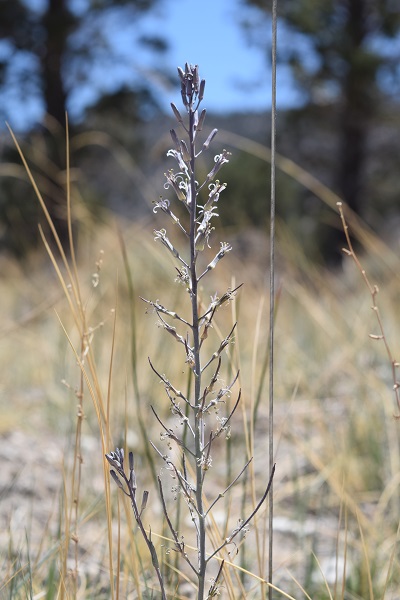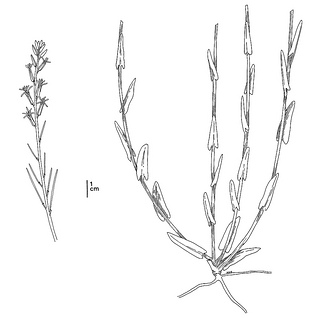(Thelypodium stenopetalum)
 Thelypodium stenopetalum. CDFW photo by Cherilyn Burton.
Thelypodium stenopetalum. CDFW photo by Cherilyn Burton.
 Thelypodium stenopetalum. CDFW illustration by Mary Ann Showers. (Click to enlarge)
Thelypodium stenopetalum. CDFW illustration by Mary Ann Showers. (Click to enlarge)
Slender-petaled thelypodium is a California endangered plant species, which means that killing or possessing plants is prohibited by the California Endangered Species Act (CESA). Slender-petaled thelypodium is also listed as endangered under the federal Endangered Species Act(opens in new tab). Slender-petaled thelypodium is a slender plant in the mustard family
with purple-tinted leaves and lavender to white flowers that typically bloom
from May to September. It is typically considered a biennial species, meaning
it has a two-year life cycle, but it may act as an annual during drought years
Slender-petaled thelypodium is found in the Big Bear Valley of the San Bernardino Mountains in alkaline meadows where the water dries out and evaporates in the summer, leaving dry, cracked soil often encrusted with salt and other minerals. The moist meadows where slender-petaled thelypodium grows are sometimes interspersed with pebble plains, which are areas of clay soils covered with a layer of orange and white quartzite pebbles that are pushed to the surface of the clay by “frost-heaving”. Frost heaving occurs during the winter months, when the frozen soil surface thaws and contracts during the day and refreezes and expands at night, pushing the cobbles to the surface. The pebble plains support a specialized plant community comprised of miniature plants adapted to these soil conditions, including several rare plant species, and slender-petaled thelypodium is often observed growing in close association with fluffy, frost-heaved soils. According to the 2011 U.S. Fish and Wildlife Service Five Year Review for Slender-Petaled Thelypodium<(PDF), meadow habitat has decreased by 91 percent in the Big Bear Valley and the nearby Holcomb Valley since the early 1900s, following the construction of Big Bear Dam and associated urban development. At the time of this webpage posting, the California Natural Diversity Database (CNDDB) lists nine occurrences of slender-petaled thelypodium that are presumed to still exist, and two historic occurrences that have become extinct. However, based on information in the U.S. Fish and Wildlife Service Five Year Review, only eight of these occurrences are presumed to still exist. Slender-petaled thelypodium has not been observed at several of occurrences in recent years, and surveys are needed to verify their status. All of the occurrences are within four main areas: Baldwin Lake, Erwin Lake, Holcomb Valley, and the south shore of Big Bear Lake. It is unknown what the original distribution of slender-petaled thelypodium was beyond the eleven historical occurrences listed in the CNDDB, but it was likely more abundant and had much more available habitat prior to the construction of Big Bear Dam.
The primary threats to slender-petaled thelypodium are urban development, altered hydrology, and climate change. Development likely caused many of the historic occurrences of slender-petaled thelypodium to go extinct and remains a threat because most occurrences are on privately-owned land. Moist meadow plant communities are likely groundwater dependent, becoming precipitation dependent after the groundwater level drops below the rooting zone of the plants. Slender-petaled thelypodium depends on a very specific hydrological habitat, and development within and surrounding this habitat causes changes to soil hydrology and depletion of groundwater, which can impact the species. Climate change may exacerbate changes in hydrology due to warmer temperatures and a shift in the timing and nature of precipitation. Off-highway vehicle use has also contributed to the extinction of occurrences in the past and continues to threaten existing populations. Additional threats to slender-petaled thelypodium include encroachment of non-native plants, grazing activities, recreation, fire management activities, and extinction from a random event.
In order to ensure the continued existence of slender-petaled thelypodium, agencies should work with landowners to protect occurrences and identify conservation opportunities on private land. Surveys should be conducted to verify the existence and health of reported occurrences. A monitoring for adaptive management program for all remaining populations should be implemented to identify threats to the population and to ensure that the populations are being managed properly. Research into the life history and specific habitat requirements of slender-petaled thelypodium should be conducted. Seed banking should also be conducted to facilitate possible future reintroduction experiments.
One of the remaining populations of slender-petaled thelypodium occurs at Baldwin Lake Ecological Reserve, managed by the California Department of Fish and Wildlife (CDFW). CDFW has implemented a monitoring for adaptive management plan for this population. More information is available in the Baldwin Lake Ecological Reserve Slender-Petaled Thelypodium Monitoring Plan with 2015-2017 Results & Discussion (PDF), dated September 2018.
CDFW may issue permits for slender-petaled thelypodium pursuant to CESA, and you can learn more about the California laws protecting slender-petaled thelypodium and other California native plants. Populations of slender-petaled thelypodium occur in CDFW’s Inland Deserts Region. More information is also available from the U.S. Fish and Wildlife Species Profile for Slender-Petaled Thelypodium.
Updated 10/25/2018